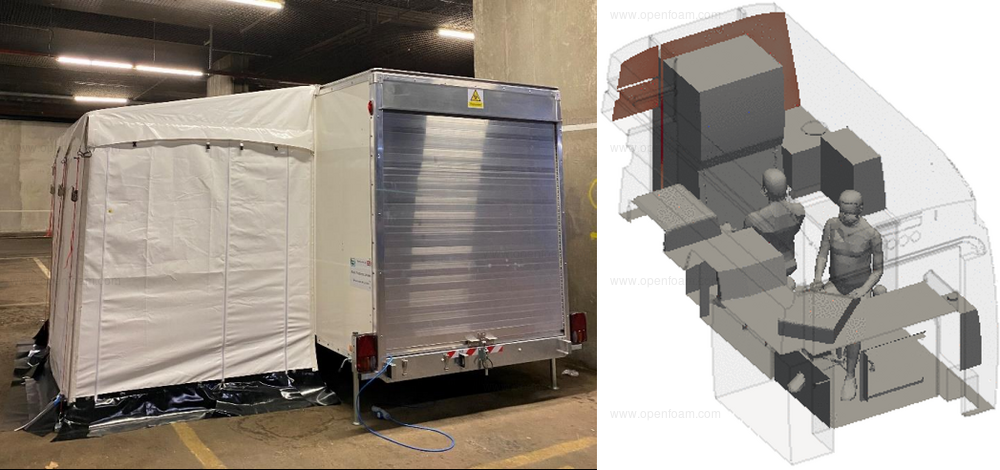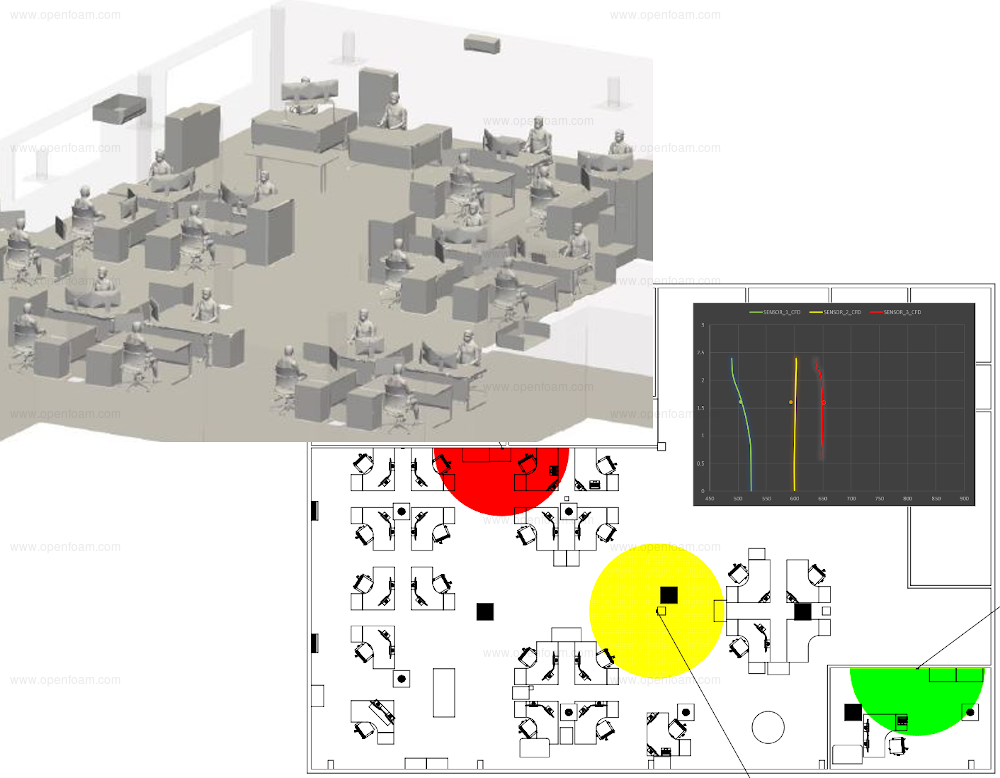Ventilation
OpenCFD has been awarded a UKRI grant (2020-2021) to investigate possibilities for mitigating airborne transmission in public spaces. Funded by Innovate UK, several case studies are presented below:
- Education: School and classrooms;
- Healthcare: Hospital treatment rooms, mobile testing/processing units;
- Offices: open plan and individual office spaces; and
- Community Centers: place of worship.
Investigations required working with UK-Government Departments, UK Professional bodies, public and private organisations:
Stakeholder study: Mobile Processing Unit

An engineering team from the military were activated to support the Department of Health and Social Care (DHSC) design and build mobile processing laboratories.
These units have been designed and built in unprecedented time, learning new concepts and processes not just in COVID-19 processing but the adaptability of static laboratory testing equipment for mobile use and the interpretations of regulations and emerging technical information regarding the SAR-COVID pathogen.
This emerging technical information, left a hole in our knowledge and development, which posed a significant risk to the development of our project. As a small team we had minimal levers of understanding the risk or more importantly articulating the possible risks.
Working with [the] team we have been able to break apart the possible problems posed by Air Flow development within our platforms. Daily engineering decisions we were making to the platform, posed significant impacts somewhere else in the design. Working with CFD, analysing the airflow and understanding the problem has allowed us to de-risk a number of significant areas of concern and more importantly has the team a body of evidence to the Chief Scientific Officer, NHS and their team that these platforms are developed appropriately.
[The] team have been instrumental in the success of this project, their support has been 100% and I could not have asked for more.
Major Ross Carter REME
Engineering Officer
Royal Electrical and Mechanical Engineering
St. Teresa's Church, RC Archdiocese of Southwark
With a footfall approximately 1000 persons per week, the aim of this study was to provide insight into the ventilation effectiveness and wellbeing of visitors to St. Teresa's church. Two scenarios were simulated, based on the wind blowing towards the Office (SE) side or Lady Chapel (NW) side:
- Without occupants and furniture
- With occupants
A key indicator of ventilation effectiveness is the 'age of air', an example of which is shown below.

Dear [Team]
Re: Ventilation Study at St. Teresa's Church, Morden, Surrey
Thank you for making us aware of your Grant Award by UK Research and Innovation (UKRI), announced on your company website https://www.openfoam.com/new/openfoam-coronavirus-response and your offer to run a ventilation study inside our church, similar to the works you have already preformed with the National Health Service, Department of Health and Social Care and the UK Army.
Yours,
Canon Michael Scanlon, KHS, Parish Priest
With the Parish Council and the Parish Team a sincere Thank You. The outcomes of your computer predictions are very insightful. We are delighted; in serving our local community of approximately 1000 visitors in the course of a typical weekend (under normal conditions) here at St. Teresa's Church in the RC Diocese of Southwark, to gain valuable confirmations as to the effectiveness of our open-window ventilation during the COVID-pandemic. It has been essential during the lockdown restrictions imposed to provide assurances to our parishioners that the fresh air ventilation in our church is adequate. The studies, which your company has performed under this Grant, together with the several measures advised by the Government and Authorities, have given us a substantial level of confidence that we serve our community with their continued safety and wellbeing in mind. Thank you sincerely for all your efforts.
Birmingham Children's Hospital
Focusing on the treatment room with a target to reduce 'fallow time', this case study was published in IPEM's SCOPE Autumn edition. The findings
- Demonstrated reduction in potential patient wait period of more than 50% by using air-cleaning technologies
- Device placement to optimise Air circulation
- AGP clearance

Dear [Team]
Let me use this quick email to thank [the team] for the work you are doing for the NHSE Air Scrubbing Programme. I think we are making very good progress in improving patient care pathways in our hospital endoscopy and dental surgery theatres. You have established CFD as central to our planning of novel engineering solutions to mitigate COVID IPC (Infection Prevention and Control) risks. Potentially, we are now in a position to substantially shorten inter-patient treatment times ('fallow periods') which will reduce our clinical waiting lists. This work will make a very real difference to our patients.
Please pass on my kind regards to your colleagues.
With best wishes, Tony
Professor A. C. Fisher
Consultant Clinical Scientist
Trust Lead Scientist
Director Merseyside Training Consortium for Medical Physics & Clinical Engineering
Head of Department
Dept. of Medical Physics & Clinical Engineering
Royal Liverpool University Hospital
Office spaces (Elta Fans Limited)
By applying CFD techniques to model open plan office environments under different ventilation conditions, insight can be readily obtained to better understand impacts on CO2 transport, thermal comfort and effectiveness of air cleaning devices.

Stepping from design [air changes per hour] to being able to actually visualise the airflow circulation and thermal environment from the modelling bring significant insights. Predicted level of CO2 from the model correlate so well with the measurements across the office space that we are confident to proceed with simulation to reassess the ventilation provided by our air handling unit (AHU).
Ana Cross, AHU Product Manager, Elta Fans Ltd.
St. Teresa's Primary School, Merton

You can find the final YouTube video by following this link and a link to the article here.
Classroom ventilation for clean air remains a priority for us to ensure good attention-span, health and wellbeing of our pupils and staff. The jargon and the science behind this can be confusing at first but, very quickly, well-chosen imagery and plain language makes the benefit tangible not just yo professionals in Education, but to our children and parents too. The collaborative work and shared learning go far beyond the obvious benefits of clean air.
Justin Dachtier, Head Teacher, St. Teresa's Primary School, Merton.









